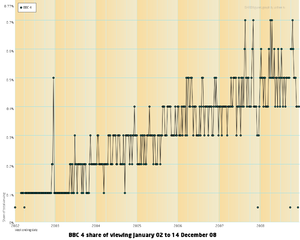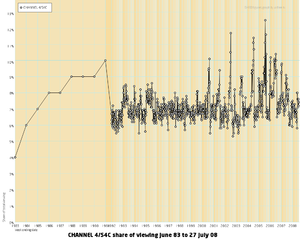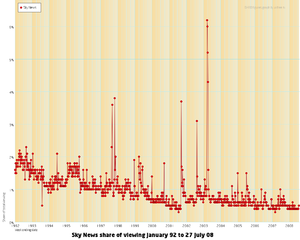BBC Three
| BBC Three | |
|---|---|
 |
|
| BBC Three logo | |
| Launched | 9 February 2003 |
| Owned by | BBC |
| Picture format | 16:9 SDTV |
| Audience share | 1.4% (July 2010, [2] BARB) |
| Country | United Kingdom |
| Replaced | BBC Choice |
| Sister channel(s) | BBC One BBC Two BBC Four BBC News BBC Parliament BBC HD |
| Website | www.bbc.co.uk/bbcthree |
| Availability | |
| Terrestrial | |
| Freeview | Channel 7 |
| Satellite | |
| Freesat | Channel 106 |
| Sky | Channel 115 |
| Astra 2D | 10773H 22000 5/6 |
| Cable | |
| Virgin Media | Channel 106 |
| UPC Ireland | Channel 116 |
| UPC Netherlands | Channel 805 |
| WightCable | Channel 106/10 |
| Ziggo (Netherlands) | Channel 52 |
| Telenet (Belgium) | Channel 565 |
| Naxoo (Switzerland) | Channel 215 |
| IPTV | |
| TalkTalk TV | Channel 19 |
| Internet television | |
| BBC Online | Watch live (UK only) |
| TVCatchup | Watch live (UK only) |
| BBC iPlayer | Watch live (UK only) |
BBC Three is a television network from the BBC broadcasting via digital cable, terrestrial, IPTV and satellite platforms. The channel's target audience includes those in the 16-34 year old age group, and has the purpose of providing "innovative" content to younger audiences, focusing on new talent and new technologies[1]. The channel is on-air from 19:00 to around 04:00 each night[1], in order to share terrestrial television bandwidth with the CBBC Channel. Unlike its commercial rivals, 90% of BBC Three's output is from the United Kingdom and other European Union countries. 80% is original, covering all genres, from current affairs, to drama, to comedy to animation. BBC Three has a unique '60 second news' format. This was adopted so that operation of the channel could be completely automated, without the complication of dealing with variable length live news broadcasts. The current controller of the station is Danny Cohen,[2] and the Head of Scheduling is Dan McGolpin.
Contents |
Launch
The channel is the successor to the similar BBC Choice and was launched on 9 February 2003, eleven months after the originally planned launch date (and the launch of BBC Four). The delay was due to debate over its proposed format - some felt it wouldn't be sufficiently different from existing commercial channels catering to young people. The channel was launched by Stuart Murphy, who previously ran BBC Choice, and before that UK Play, the now-discontinued UKTV music and comedy channel on which ran Rock Profile, by Matt Lucas and David Walliams (who went on to star in Little Britain). At 33, Murphy was the youngest channel controller in the country, a title he held since launching UK Play at the age of 26, although on 20 October 2005 it was announced that Murphy was soon to leave the channel to work in commercial television.
Identity
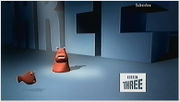
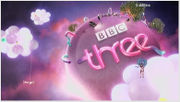
The channel's original idents were conceived by Stefan Marjoram at Aardman Animations and were used from launch until February 2008. Stuart Murphy was touring Aardman Animations looking for new programming ideas for BBC Three when he spotted the cone shaped creatures, he then took the idea back to the Lambie-Nairn agency, responsible for the BBC Three identity package.[3] A feature of this identity is also the music "Three Is The Magic Number", based (only the lyrics are copied) upon Schoolhouse Rock!.
BBC Online provided a number of downloads and activities based on the channel's identity, these included "BlobMate", screensavers, wallpapers and also games such as BlobLander and BlobBert. The idea used by both Lambie-Nairn, who had developed the branding for CBeebies and CBBC, and Aardman, was to create the BBC Three blobs as a relation to the green and yellow blobs of the children's channels. Up until they rebranded the channel, it had two continuity announcers, Kieron Elliott, who has a Scottish accent, and also presents the breakfast show on 96.3 Rock Radio, and a female, Lola Buckley who has a Yorkshire accent. Presently the continuity announcements are done by either Collette Collins or Gavin Inskip.
On 22 January 2008 a new channel identity was unveiled. Rebranding was carried out by Red Bee Media, along with agencies MPG and Agency Republic with music and sound design by creative audio company Koink.[4]
Programming
Milestones
In early 2003, viewers could watch episodes of popular BBC soap opera EastEnders on BBC Three before they were broadcast on BBC One. This programming decision coincided with the relaunch of the channel and helped it break the one million viewers milestone for the first time. An episode of EastEnders Revealed, which was commissioned for BBC Three, attracted 611,000 viewers.
In October 2004, BBC Three broke its previous viewing record when 1.8 million viewers tuned in for a new series of the award-winning comedy, Little Britain.[5] Little Britain was later broadcast on the BBC's terrestrial analogue channels BBC One and BBC Two. In the same year, the newly commissioned Chris Crudelli hit Mind, Body & Kick Ass Moves was exported to over 100 countries.
In 2005, BBC Three showed the documentary series Doctor Who Confidential immediately after episodes of the new series of Doctor Who had been screened on BBC One. This was followed up in July 2005, when it began to screen repeats of both programmes. Coincidentally, the 1971 Doctor Who story The Dæmons featured a broadcast on a then-fictional BBC Three. In October 2005, it was announced that BBC Three had commissioned a spin-off drama series from Doctor Who, Torchwood, designed as a post-watershed science fiction drama for a more adult audience. Torchwood launched with an impressive 2.4 million viewers in October 2006, breaking BBC Three's previous record of 1.8 million for Little Britain.[6]Torchwood is the first science fiction programme ever to have been commissioned by the channel, although it had previously shown repeats of Doctor Who and imported programmes such as Farscape.
In 2006, BBC Three aired the first run of a back-up show for BBC Two's The Apprentice, You're Fired! until sport and high ratings moved it to BBC Two.
In 2010, BBC Three began airing episodes of the fifth series of BBC drama series Waterloo Road after they had aired on BBC One as part of its 'catch-up' programming.
Other programmes
Other new programmes have included:
- Mongrels
- Lee Nelson's Well Good Show
- Waterloo Road
- Ideal
- Funland, described as being a 'disturbingly funny new thriller', which first aired on Sunday 23 October 2006 at 22:00 ( It has since been repeated on prime-time BBC One).
- Tittybangbang, a comedy sketch show starring Lucy Montgomery and Debbie Chazen, which first aired on 10 January 2006, and featured a range of bizarre characters.
- Nighty Night
- The Smoking Room
- Man Stroke Woman, a sketch show, starring Nick Frost and Nick Burns, mostly dealing with relationships of 20- and 30-somethings, which first aired on 21 November 2005, subsequently being repeated on BBC Two due to its success.
- Monkey Dust was twisted adult animation which graphically depicted many stereotypes such as paedophilia, racism and youth 'hoodie' violence.
- Two Pints of Lager and a Packet of Crisps (the channel's longest running comedy)
- The Mighty Boosh
- The Coffee Shop (2010) new sitcom
- Coming of Age
- Family Guy In 2010 BBC3 will air a Family Guy weekend which consists of a Countdown of the Top 20 Family Guy Characters, A special documentary on the show (similar to what they did the previous year where it aired two other documentaries with the season 7 premiere in 2009), the debut of Family Guy creator Seth MacFarlane & Alex Borstien's Comedy Road Show and a double-bill premiere of Season 8 of the show.
- American Dad
- Dancing with Downs
- Gavin & Stacey (first aired in May, 2007) written by and starring Ruth Jones and James Corden alongside Mathew Horne, Joanna Page, Alison Steadman and Rob Brydon.
- Last Man Standing (a reality TV show) narrated by Ralf Little, series one was aired from 26 June to 14 August 2007 and series two began on 14 October 2008.
- Lily Allen and Friends, a variety show based on social networking, hosted by Lily Allen,[7] a multi-platform talent show.
- Upstaged presented by DJ Scott Mills, a multi-platform talent show broadcast on BBC Three and the internet.
- a series of "hard-hitting" documentaries aimed at a young audience and six new drama pilots.[8]
- Phoo Action (which is to be made into a full series).[9]
- Being Human (which has now been made into a series)
- Mrs Inbetweeny
- West 10 LDN
- The Things I Haven't Told You
- Dis/Connected
- Russell Howard's Good News
- New BBC Three comedy sketch series Horne and Corden debuted 10 March 2009, to the highest ratings of all BBC Three comedy debuts.[10]
- Match of the Day Live international football matches featuring Wales are often shown if an England match is being shown on BBC One. The channel also shows some matches of England's Women's team. The 2008 Africa Cup of Nations was shown on the channel from 20 January – 10 February 2008.
BBC Three is also home to many pan-psychology based programmes which bring topics such as addictions and childcare into an entertainment and educational context. Such programmes include:
- Freaky Eaters
- Spendaholics
- Spastic or Plastic
- The House of Tiny Tearaways
- Sex..with Mum & Dad
- Little Angels (TV series)
BBC Three has also focused on the beauty market, with the 'Beauty season' as well as continuous beauty shows. These include: 'Jamelia: Whose Hair Is It Anyway?", 'Look But Don't Touch' (presented by Alesha Dixon), and one of the channel's top shows: Snog Marry Avoid?.
The channel features hourly news updates called 60 Seconds, presented by Tasmin Lucia Khan during the week, which include the top news, sport and entertainment stories. They are presented in a relaxed style in keeping with the rest of the channel. As part of the BBC's discussions with the government regarding the founding of the channel, a longer news programme had been promised to provide a daily section of news and current affairs. The News Show, as it came to be called upon launch was later rebranded The 7 O'Clock News. However, the BBC discontinued the bulletin in 2005, claiming that the programme's audience was minuscule and the output was provided elsewhere on the BBC.
Viewership
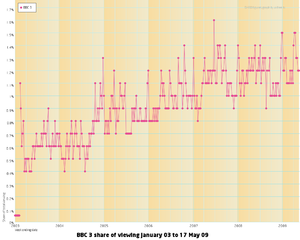
The channel is aimed at 16-34 year olds,[11] and competes with other digital channels including ITV2 and E4.[12]
In 2008 it reached 26.3% of 16-34 year olds in digital homes — the channel's highest ever such reach and above that of E4, ITV2, Dave and Sky One.[13]
Meanwhile, Its share of the audience during its transmission hours is 2.6% among 15-34 year olds, and 1.7% among all individuals. BARB, the official ratings agency, averages out BBC Three's viewing figures over 24 hours even though the channel only broadcasts in the evening, giving a distorted sense of the channel's viewership. Despite several official complaints from the BBC, BARB continues to publish figures which the BBC argues are unrepresentative. Nine million people watch BBC Three every week.[5]
The following is a list of the ten most watched broadcasts on BBC Three, from BARB data up to 21 February 2010.[14]
| Rank | Show | Episode | Number of Viewers (thousands) | Date |
|---|---|---|---|---|
| 1 | Eastenders Live: The Aftermath | N/A | 4,537 | 19 February 2010 |
| 2 | Torchwood | 1.1 Everything Changes | 2,519 | 22 October 2006 |
| 3 | Torchwood | 1.2 Day One | 2,498 | 22 October 2006 |
| 4 | The Weakest Link | Eastenders Special | 2,005 | 19 February 2010 |
| 5 | Eastenders | 07/07/2009 | 1,907 | 7 July 2009 |
| 6 | Gavin & Stacey | 2.1 | 1,894 | 16 March 2008 |
| 7 | Gavin & Stacey | 2.2 | 1,869 | 16 March 2008 |
| 8 | Gavin & Stacey | 2.4 | 1,799 | 30 March 2008 |
| 9 | Eastenders | 31/03/2009 | 1,795 | 31 March 2009 |
| 10 | Eastenders | 09/04/2009 | 1,782 | 9 April 2009 |
Awards
The channel has had critical and popular successes, winning more awards in its six year history than its commercial rivals (Sky One, Living, E4, ITV2, Five and Comedy Central) have won in their combined 25-year history. In total BBC Three has won 7 BAFTA awards, 5 British Comedy Awards, 15 Royal Television Society Awards and 5 Rose d'Or Awards since the channel was launched in February 2003. Most recently, it won Broadcast Magazine's Digital Channel of the Year Award for Best General Entertainment Channel, and MGEITF Non Terrestrial Channel of the Year.
All three of BBC Three's dramas produced in 2004 (Outlaws, Bodies and Conviction) received BAFTA nominations, as did classical music show Flashmob The Opera
In 2008, BBC Three's Gavin and Stacey won the BAFTA audience award and the best comedy performance award was awarded to James Corden for his part.
Criticism
The channel has also come in for criticism from several corners, the most prominent of which are some of the BBC's long-standing presenters. These include John Humphrys, who argued that BBC Three and BBC Four should be shut down in the face of budget cuts to BBC Radio 4's Today programme, which he presents,[15] John Sweeney of Panorama,[16] and Jeremy Paxman are among other journalists have also criticised the channel and its content.[17]
References
- ↑ 1.0 1.1 BBC Three Service License, August 2009. Retrieved 2010-03-31.
- ↑ "BBC - Press Office - Danny Cohen named Controller of BBC Three". http://www.bbc.co.uk/pressoffice/pressreleases/stories/2007/04_april/10/three.shtml. Retrieved 2008-08-11.
- ↑ "The TV Room - BBC Three - February 2003-February 2008". http://thetvroom.com/bbcuk/bbc-3-01-01.html. Retrieved 2009-04-05.
- ↑ "Home - Creative Production - Original Music - Koink". http://www.koink.uk.com. Retrieved 2008-08-11.
- ↑ 5.0 5.1 The British Broadcasting Corporation (2006-02). "Key Facts: BBC Three". Press release. http://www.bbc.co.uk/pressoffice/keyfacts/stories/bbcthree.shtml. Retrieved 2007-01-08.
- ↑ "Torchwood scores record audience". BBC News. 2006-10-23. http://news.bbc.co.uk/1/hi/entertainment/6077078.stm. Retrieved 2008-01-03.
- ↑ "BBC - Lily Allen and Friends". http://www.bbc.co.uk/lilyallen/. Retrieved 2008-08-11.
- ↑ "BBC - Press Office - BBC Three commissions documentaries season". http://www.bbc.co.uk/pressoffice/pressreleases/stories/2007/09_september/09/young.shtml. Retrieved 2008-08-11.
- ↑ "BBC - Press Office - BBC Three drama pilots herald new younger drama". http://www.bbc.co.uk/pressoffice/pressreleases/stories/2007/07_july/10/pilots.shtml. Retrieved 2008-08-11.
- ↑ 'Horne And Corden' breaks BBC record DigitalSpy
- ↑ "BBC - Press Office - BBC Three key facts". http://www.bbc.co.uk/pressoffice/keyfacts/stories/bbcthree.shtml. Retrieved 2008-08-11.
- ↑ "Is BBC Three a commercial threat? - Brand Republic Login - Brand Republic". http://www.brandrepublic.com/login/News/779694/. Retrieved 2008-08-11.
- ↑ "BBC Trust Service Review Younger audiences: BBC Three, Radio 1 and 1Xtra". http://www.bbc.co.uk/bbctrust/assets/files/pdf/regulatory_framework/service_licences/service_reviews/yar/yar_review.pdf/. Retrieved 2009-06-22.
- ↑ BARB, via [1]
- ↑ Ian Burrell (3 September 2007). "Humphrys: BBC cost-cutters should axe new channels". The Independent (London). http://www.independent.co.uk/news/media/humphrys-bbc-costcutters-should-axe-new-channels-401269.html. Retrieved 08-05-2008.
- ↑ Daniel Bates (3 September 2007). "Scrap BBC Three and Four to save prestigious programmes, says veteran journalist John Humphrys". Daily Mail (London). http://www.dailymail.co.uk/pages/live/articles/news/news.html?in_article_id=479553&in_page_id=1770. Retrieved 08-05-2008.
- ↑ Camilla Cavendish (5 July 2007). "BBC Three and Four, your number's up". The Times (London). http://www.timesonline.co.uk/tol/comment/columnists/camilla_cavendish/article2028767.ece. Retrieved 08-05-2008.
External links
|
|||||||||||
|
||||||||||||||||||||||||||


